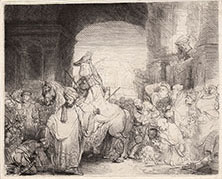Leiden 1606 – Amsterdam 1669
Painter, draughtsman and etcher of portraits, landscapes and historical and biblical subjects, Rembrandt was a Dutch Master and one of the great artists of all time.
Born in Leiden the son of a mill-owner, in 1620 after completing his tuition at the Leiden Latin School enrolled at Leiden University. However, Rembrandt wasn’t inspired by studying and he left university to begin an apprenticeship as a painter in Leiden. In 1624, he spent his first period of time in Amsterdam where he was able to study under a famous painter called Pieter Lastman. Back in Leiden, he set himself up as an independent painter and worked closely with Jan Lievens. In or around 1631 he settles permanently in Amsterdam. Rembrandt was one of the greatest storytellers in the history of art, possessing an exceptional ability to render people in their various moods and dramatic guises. He is also known as a painter of light and shade and as an artist who favoured an uncompromising realism.
Early in his career and for some time, Rembrandt painted mainly portraits. Although he continued to paint—and etch and, occasionally, draw—portraits throughout his career, he did so less frequently over time. Roughly one-tenth of his painted and etched oeuvre consists of studies of his own face as well as more-formal self-portraits. The core of Rembrandt’s oeuvre, however, consists of biblical and—to a much lesser extent—historical, mythological, and allegorical “history pieces,” all of which he painted, etched, or sketched in pen and ink or chalk. Seen over his whole career, the changes in Rembrandt’s style are remarkable. His approach to composition and his rendering of space and light—like his handling of contour, form, and colour, his brushwork, and (in his drawings and etchings) his treatment of line and tone—are subject to gradual (or sometimes abrupt) transformation, even within a single work.
About 1628 Rembrandt made his first etchings. Unlike drawing, etching is not a natural counterpart to painting, and his decision to begin etching meant taking a significant new direction in his career. Much of his international fame during his lifetime would be based on the widely disseminated prints he produced. Analysis of Rembrandt’s early etched oeuvre gives the impression that he was basically self-taught in this field. Whereas Rembrandt’s contemporaries adopted the regular, almost stylized manner of applying lines and hatchings that could be found in the much more common copper engravings, Rembrandt almost from the outset used a much freer technique, developing a method of working that appears partly sketch-like, yet which could also be described as painterly. The painterly quality of his etchings is mainly due to the way in which he achieved an extraordinarily suggestive play of light and dark and how he created a convincing sense of atmospheric space using different methods of hatching.
To learn more about Rembrandt's art and life, I recommend visiting the site of the Rembrandt House.
